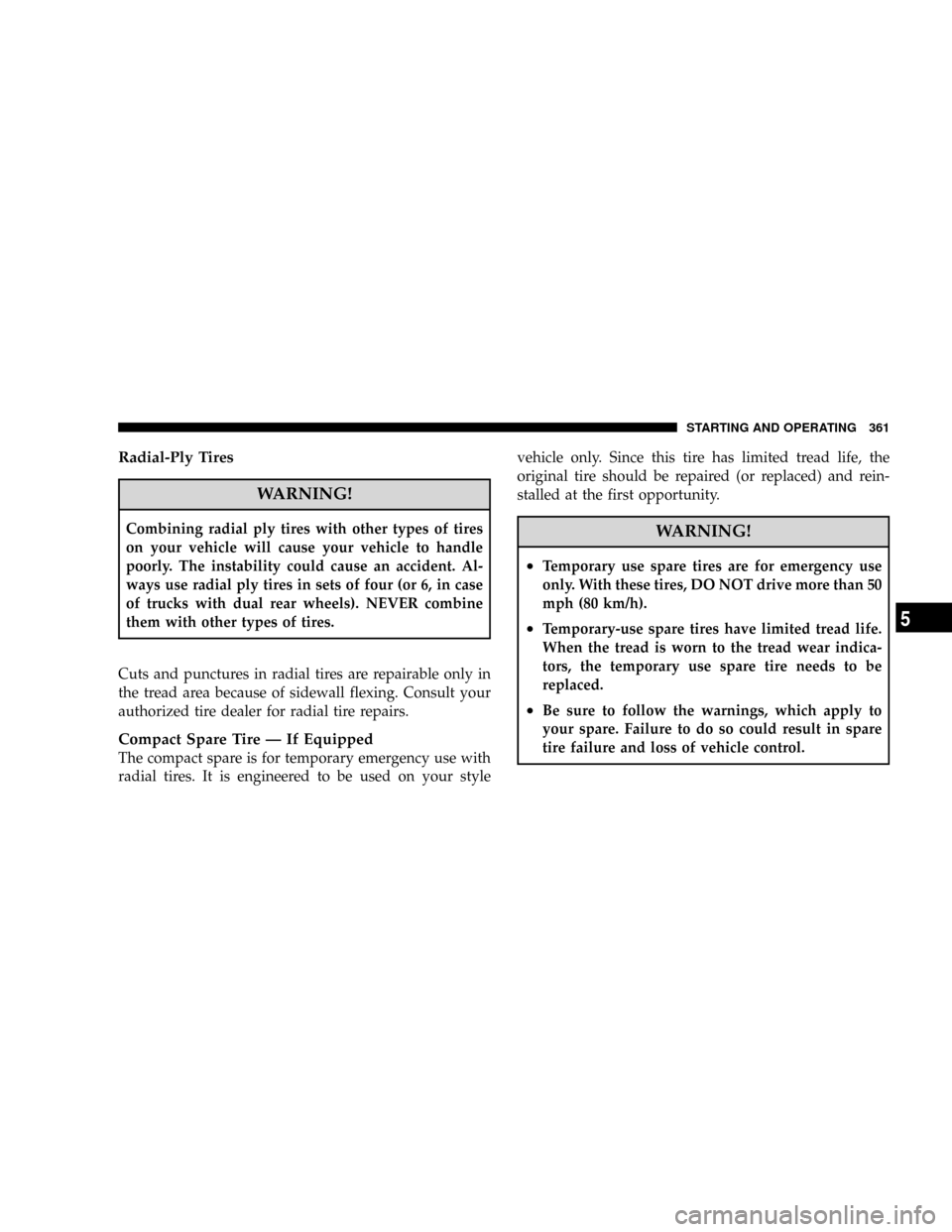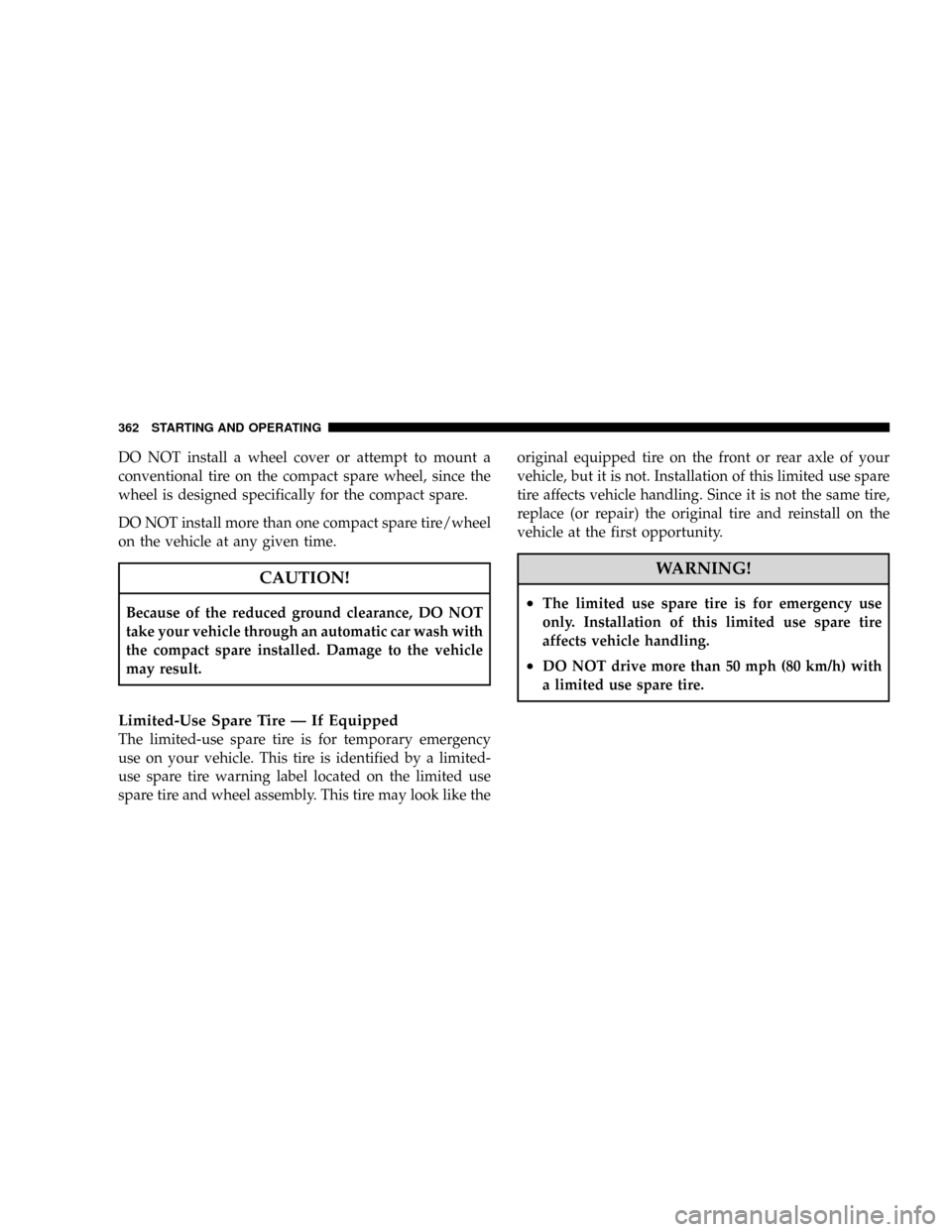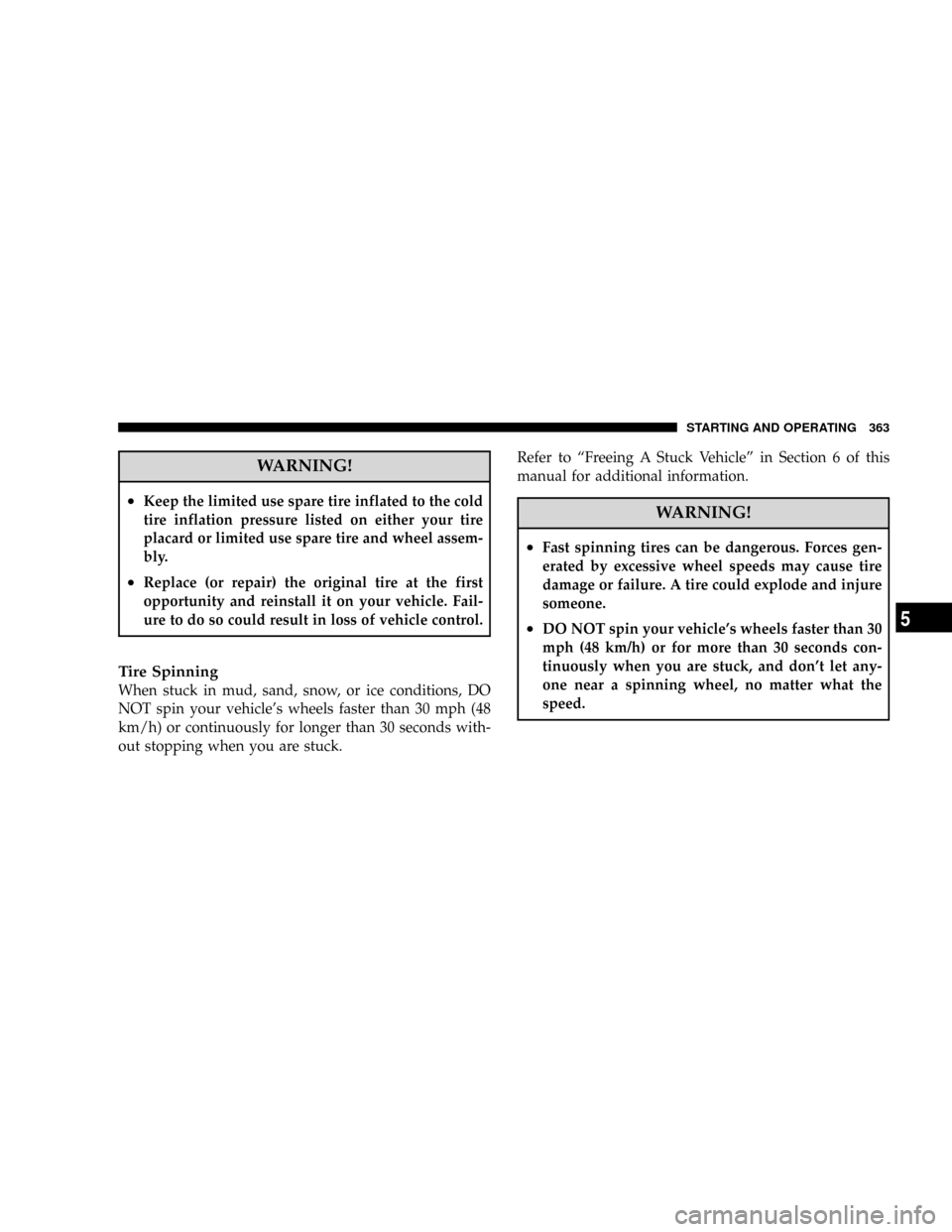Page 96 of 531

Airbag Light
The light should come on and remain on for four seconds
as a bulb check when the ignition switch is first turned
ON. If the LED is not lit during starting and/or the light
stays on or comes ON while driving, have the system
checked by an authorized dealer.
Defroster
Check operation by selecting the defrost mode and place
the blower control on high speed. You should be able to
feel the air directed against the windshield.
NOTE:If the defroster is not working or you are unable
to feel air against the windshield in defrost mode, please
see your authorized dealer service center for repairs.
PERIODIC SAFETY CHECKS YOU SHOULD MAKE
OUTSIDE THE VEHICLE
Tires
Examine tires for excessive tread wear or uneven wear
patterns. Check for stones, nails, glass, or other objects
lodged in the tread. Inspect tread and sidewall for cuts or
cracks. Check wheel nuts for tightness, and tires (includ-
ing spare) for proper pressure.
Lights
Have someone observe the operation of exterior lights
while you work the controls. Check turn signal and high
beam indicator lights on the instrument panel.
Fluid Leaks
Check area under vehicle after overnight parking for fuel,
engine coolant, oil or other fluid leaks. Also, if gasoline
fumes are detected or fuel, power steering fluid, trans-
mission fluid or brake fluid leaks are suspected, the cause
should be located and corrected immediately.
94 THINGS TO KNOW BEFORE STARTING YOUR VEHICLE
Page 236 of 531

during starting, stays on, or turns on while driving, have
the system inspected by an authorized dealer as soon as
possible.
23. Voltage Light
This light monitors the electrical system voltage.
The light should turn on momentarily as the
engine is started. If the light stays on or turns on while
driving, it indicates a problem with the charging system.
Immediate service should be obtained.
24. Low Fuel Light
When the fuel level reaches approximately 2.0
gallons (7.8 liters) this light will turn on and remain
on until fuel is added.25. Tire Pressure Monitoring Telltale Lamp Ð If
Equipped
Each tire, including the spare (if provided),
should be checked monthly when cold and in-
flated to the inflation pressure recommended by
the vehicle manufacturer on the vehicle placard
or tire inflation pressure label. (If your vehicle has tires of
a different size than the size indicated on the vehicle
placard or tire inflation pressure label, you should deter-
mine the proper tire inflation pressure for those tires.)
As an added safety feature, your vehicle has been
equipped with a Tire Pressure Monitoring System
(TPMS) that illuminates a low tire pressure telltale when
one or more of your tires is significantly under-inflated.
Accordingly, when the low tire pressure telltale illumi-
nates, you should stop and check your tires as soon as
possible, and inflate them to the proper pressure. Driving
on a significantly under-inflated tire causes the tire to
overheat and can lead to tire failure. Underinflation also
234 UNDERSTANDING YOUR INSTRUMENT PANEL
Page 351 of 531

NOTE:
²P (Passenger) - Metric tire sizing is based on U.S.
design standards. P-Metric tires have the letter ªPº
molded into the sidewall preceding the size designa-
tion. Example: P215/65R15 95H.
²European-Metric tire sizing is based on European
design standards. Tires designed to this standard have
the tire size molded into the sidewall beginning with
the section width. The letter9P9is absent from this tire
size designation. Example: 215/65R15 96H.
²LT (Light Truck) - Metric tire sizing is based on U.S.
design standards. The size designation for LT-Metric
tires is the same as for P-Metric tires except for the
letters ªLTº that are molded into the sidewall preced-
ing the size designation. Example: LT235/85R16.
²Temporary spare tires are high-pressure compact
spares designed for temporary emergency use only.
Tires designed to this standard have the letter ªTº
molded into the sidewall preceding the size designa-
tion. Example: T145/80D18 103M.
²High flotation tire sizing is based on U.S. design
standards, and it begins with the tire diameter molded
into the sidewall. Example: 31x10.5 R15 LT.
STARTING AND OPERATING 349
5
Page 352 of 531
Tire Sizing Chart
Tire Sizing Chart
PPassenger Car tire size based on U.S. design standards
(....blank....(Passenger Car tire based on European design standards
LTLight Truck tire based on U.S. design standards
TTemporary spare tire
31Overall diameter in inches (in)
215Section width in millimeters (mm)
65Aspect Ratio of section height to section width of tire, written in percent (%)
10.5Section width in inches (in)
R9R9means radial construction
9D9means diagonal or bias construction
15Rim diameter in inches (in)
95Load Index (a numerical code associated with the maximum load a tire can carry)
350 STARTING AND OPERATING
Page 355 of 531
Tire Loading and Tire Pressure
Tire Placard Location
NOTE:The proper cold tire inflation pressure is listed
on either the face of the driver's door or the driver's side
B-Pillar.
Tire and Loading Information Placard
This placard tells you important information about the:
1) number of people that can be carried in the vehicle
2) total weight your vehicle can carry
3) tire size designed for your vehicle
4) cold tire inflation pressures for the front, rear, and
spare tires.
Tire Placard Location
Tire and Loading Information Placard
STARTING AND OPERATING 353
5
Page 363 of 531

Radial-Ply Tires
WARNING!
Combining radial ply tires with other types of tires
on your vehicle will cause your vehicle to handle
poorly. The instability could cause an accident. Al-
ways use radial ply tires in sets of four (or 6, in case
of trucks with dual rear wheels). NEVER combine
them with other types of tires.
Cuts and punctures in radial tires are repairable only in
the tread area because of sidewall flexing. Consult your
authorized tire dealer for radial tire repairs.
Compact Spare Tire Ð If Equipped
The compact spare is for temporary emergency use with
radial tires. It is engineered to be used on your stylevehicle only. Since this tire has limited tread life, the
original tire should be repaired (or replaced) and rein-
stalled at the first opportunity.
WARNING!
²Temporary use spare tires are for emergency use
only. With these tires, DO NOT drive more than 50
mph (80 km/h).
²Temporary-use spare tires have limited tread life.
When the tread is worn to the tread wear indica-
tors, the temporary use spare tire needs to be
replaced.
²Be sure to follow the warnings, which apply to
your spare. Failure to do so could result in spare
tire failure and loss of vehicle control.
STARTING AND OPERATING 361
5
Page 364 of 531

DO NOT install a wheel cover or attempt to mount a
conventional tire on the compact spare wheel, since the
wheel is designed specifically for the compact spare.
DO NOT install more than one compact spare tire/wheel
on the vehicle at any given time.
CAUTION!
Because of the reduced ground clearance, DO NOT
take your vehicle through an automatic car wash with
the compact spare installed. Damage to the vehicle
may result.
Limited-Use Spare Tire Ð If Equipped
The limited-use spare tire is for temporary emergency
use on your vehicle. This tire is identified by a limited-
use spare tire warning label located on the limited use
spare tire and wheel assembly. This tire may look like theoriginal equipped tire on the front or rear axle of your
vehicle, but it is not. Installation of this limited use spare
tire affects vehicle handling. Since it is not the same tire,
replace (or repair) the original tire and reinstall on the
vehicle at the first opportunity.
WARNING!
²The limited use spare tire is for emergency use
only. Installation of this limited use spare tire
affects vehicle handling.
²DO NOT drive more than 50 mph (80 km/h) with
a limited use spare tire.
362 STARTING AND OPERATING
Page 365 of 531

WARNING!
²Keep the limited use spare tire inflated to the cold
tire inflation pressure listed on either your tire
placard or limited use spare tire and wheel assem-
bly.
²Replace (or repair) the original tire at the first
opportunity and reinstall it on your vehicle. Fail-
ure to do so could result in loss of vehicle control.
Tire Spinning
When stuck in mud, sand, snow, or ice conditions, DO
NOT spin your vehicle's wheels faster than 30 mph (48
km/h) or continuously for longer than 30 seconds with-
out stopping when you are stuck.Refer to ªFreeing A Stuck Vehicleº in Section 6 of this
manual for additional information.
WARNING!
²Fast spinning tires can be dangerous. Forces gen-
erated by excessive wheel speeds may cause tire
damage or failure. A tire could explode and injure
someone.
²DO NOT spin your vehicle's wheels faster than 30
mph (48 km/h) or for more than 30 seconds con-
tinuously when you are stuck, and don't let any-
one near a spinning wheel, no matter what the
speed.
STARTING AND OPERATING 363
5